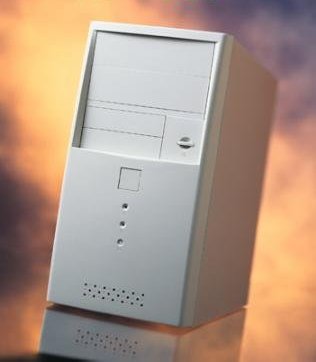[ The PC Guide | Systems and Components Reference Guide | System Case | Form Factors ]
microATX and FlexATX Form Factor
Computer manufacturers continue to want to shrink the size of their systems, and Intel has been happy to oblige, with another variant on the basic ATX theme called "microATX". (Why no capital "M"? Ask Intel, I have no idea. :^) ) As the name implies, microATX is not only smaller still than Mini ATX, it is actually smaller than even NLX. microATX is intended for the medium to low-end market that Intel has decided to target with force.
Technically, it could be said that microATX is not even really a case form factor, because microATX is in fact a motherboard standard. However, with the smaller microATX motherboards, manufacturers are creating smaller cases to fit. To complement microATX, Intel created a new, low-output power supply design called SFX. SFX power supplies are designed to work with not only microATX systems, but also NLX and regular ATX systems, and this is why these power supplies were not called microATX (though for most full-sized ATX systems, the SFX power supply may not be of sufficient capacity.) SFX and microATX are sometimes used interchangeably, or together, in describing this general physical format.
|
A microATX mini tower case. |
Image � In
Win Development, Inc. |
microATX defines as part of its standard, maximum motherboard dimensions of 9.6"x9.6". To allow the creation of systems even smaller than those made possible by microATX, Intel in 1999 created a variant of microATX called FlexATX (hey, the initial capital letter is back! :^) ) FlexATX motherboard have maximum dimensions of just 9"x7.5", making them the smallest of the ATX family. FlexATX motherboards use the same mounting holes as microATX ones, so they can in theory be mounted into microATX cases; the point of FlexATX however is to further reduce physical case size for the most inexpensive of PC systems. Further placing FlexATX squarely in the realm of the lower-cost PC is the fact that these systems are limited to only socketed processors (CPUs using SEC technology being excluded due to their larger size.)
microATX and FlexATX are of little interest to most serious PC enthusiasts or homebuilders, due to their very limited capacity and expandability. (To give you an idea of what I mean by this, the SFX power supply standard is 90W of continuous power, though higher-capacity models are available.) This form factor may, however, become of interest to the manufacturers of low-end PCs. It seems to me that there is some overlap between NLX and microATX, and it will be interesting to see how much ground microATX makes against NLX, a standard already becoming popular amongst volume manufacturers. FlexATX will probably be exploited by the makers of retail PCs trying to capture the bottom end of the market.
You can find detailed specifications about microATX, FlexATX and other newer form factors at the Platform Development Support Web Site.
![]() Next: WTX
Form Factor
Next: WTX
Form Factor
| The PC Guide
(http://www.PCGuide.com) Site Version: 2.2.0 - Version Date: April 17, 2001 © Copyright 1997-2004 Charles M. Kozierok. All Rights Reserved. |
Not responsible for any loss resulting from the use of this site. Please read the Site Guide before using this material. |
